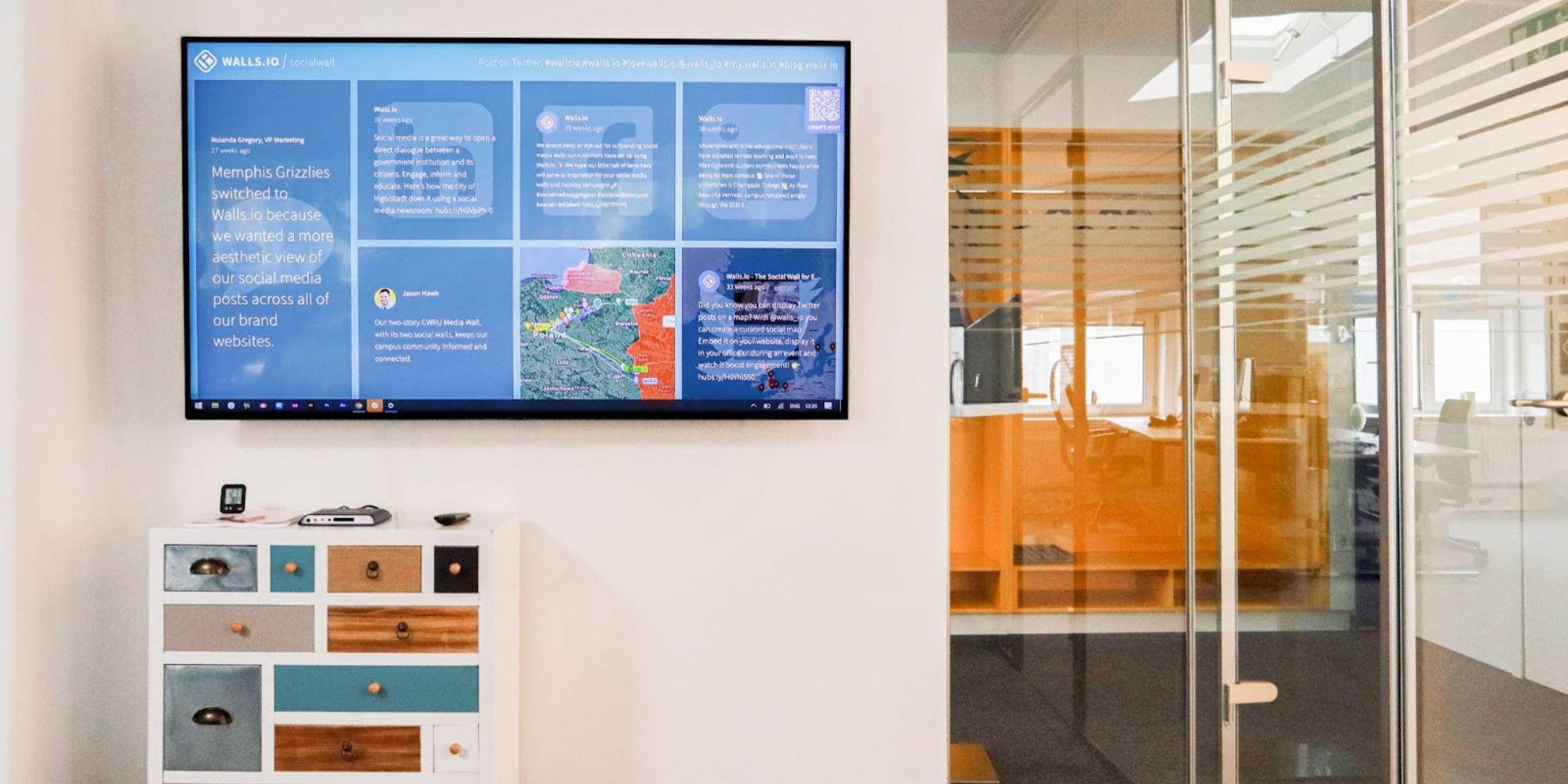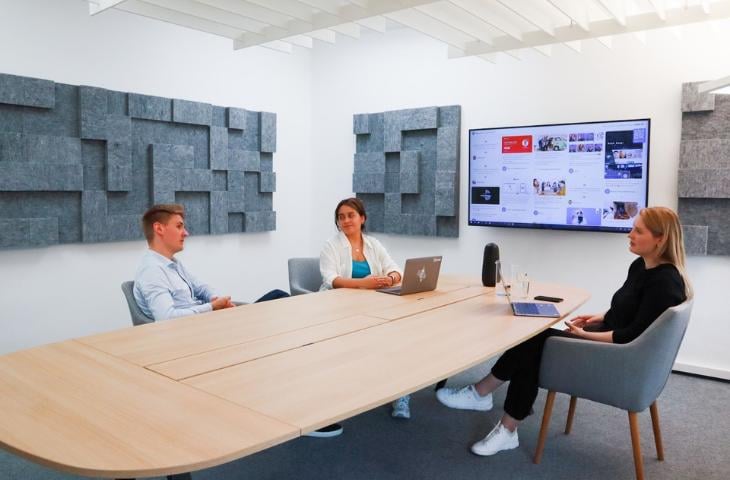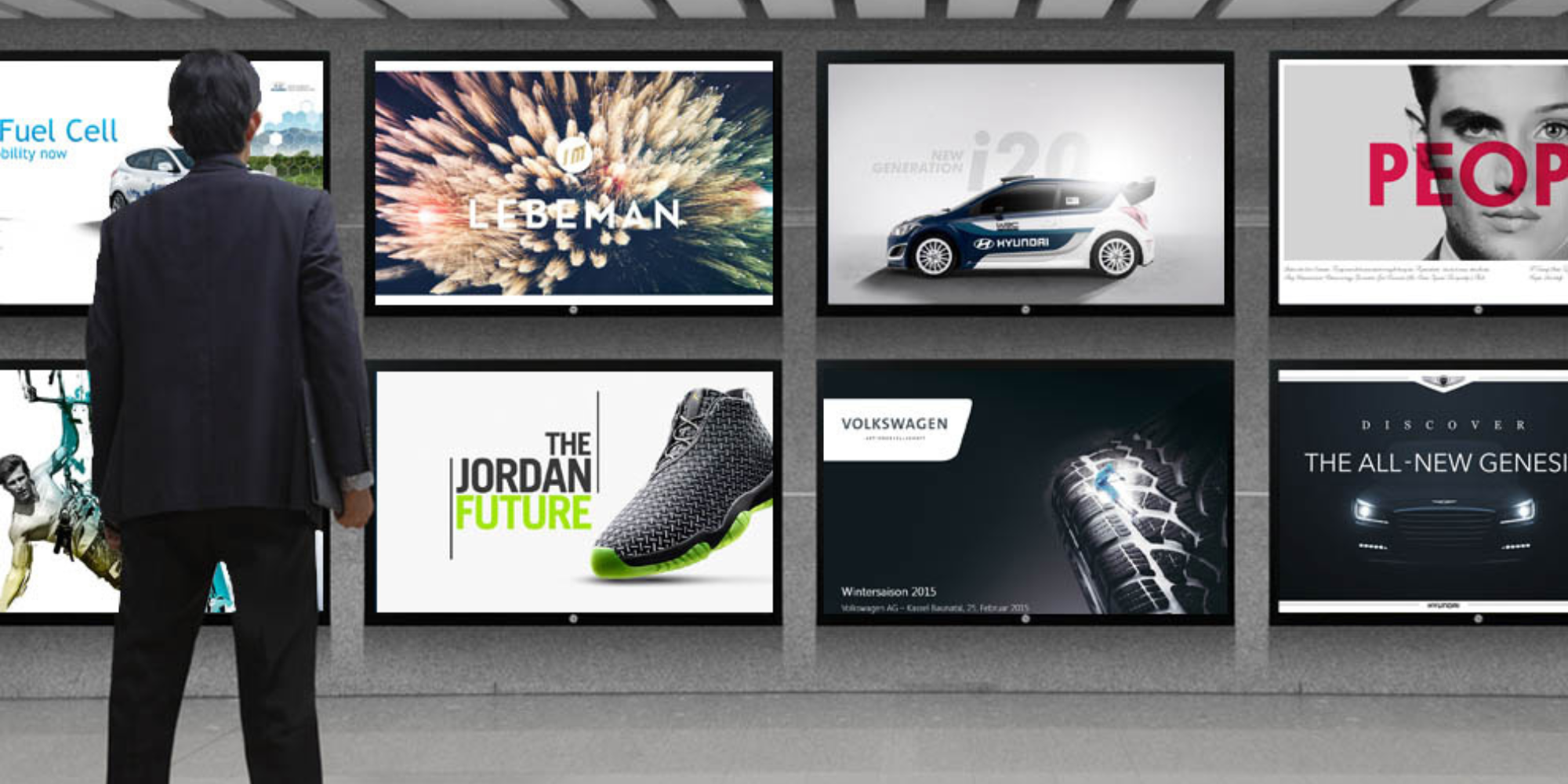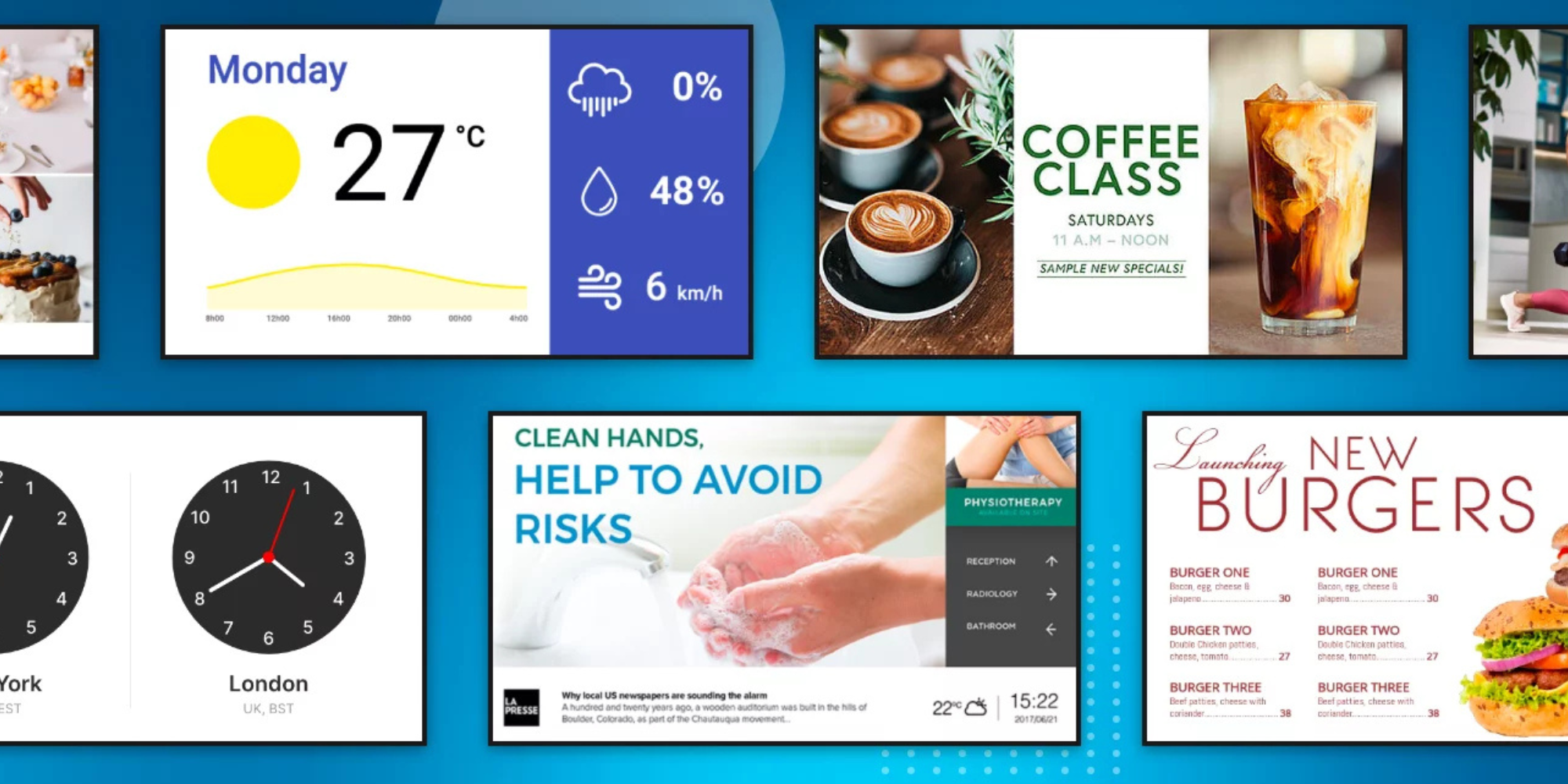
Digital Signage VS Normal TV: What’s The Difference?
Businesses from all kinds of industries have introduced cloud based digital signage into their day-to-day operations, be it to advertise, communicate with customers, or improve operational processes. Digital displays are all around us — in offices, bars, and shopping malls, at airports and metro stations, on buildings, and even on vehicles. But what is so special about digital signage and why wouldn’t a regular television set do the same? Let’s find out more about the differences between digital signage and normal TVs.
Main Differences Between Digital Signage and TVs
In general, digital signs and TVs serve a similar purpose — they convey visual (static or dynamic) messages. However, there are some major differences between the two. Knowing them could help you decide which one to pick for your business’s needs.
Types of Displays

There are several different types of screens that are commonly used for digital signage, the most common ones being LCD (liquid-crystal display) and LED (light-emitting diode). Some newer digital signage solutions also make use of OLED screens, too.
Digital signage displays can also come in various formats, such as video walls (i.e. multi screen digital signage), hand-held tablets, and so on. Digital signage can also be interactive (through the use of touch-screen technology.
Although television sets today largely use the same display technology (LCD), they are much more limited in terms of shape and size. Touch-screen television sets are also still relatively rare.
Functionality
Another major difference between digital signage and television is the functionality behind the technology. Television sets are designed for watching TV. With the emergence of connected TVs, they are also commonly used to access online content, too.
On the other hand, digital signage displays are designed to integrate with digital signage software. This software allows users to easily display their desired messaging through the content management system.
Durability
Most people don’t watch television 24/7. Therefore, most television sets aren’t designed to be turned on all the time. According to Finer Home Living, leaving a TV on with a static image for more than a couple of hours will almost certainly result in screen burn (discoloration of the screen in some areas or across the whole surface).
On the other hand, digital signage displays are designed specifically with 24/7 usage in mind, so they are resistant to screen burn and much less likely to overheat than a regular TV.
Cost
The precise cost of digital signage depends on several factors, such as the setup, number and size of displays, type of software, and so on. In general, it can cost anywhere from a couple of hundred to a couple of thousand dollars to set up a digital signage system.
The situation is more or less similar with TVs. There are television sets going for as low as a couple of hundred dollars. Large, high-def TVs, though, can go well into the thousands.
If we’re talking about averages, however, digital signage generally requires a larger initial investment.
Benefits of Digital Signage Over Normal TV

We’ve covered the major differences between digital signage displays and TVs, but what is it that makes digital signs better for commercial use? Why do so many businesses decide to invest in digital signage despite it generally costing more? Here are the main reasons.
Versatility
While TVs do have some variation in shape and size, they are all generally table-top or wall-mounted rectangular screens. Digital signs, however, can range from hand-held devices to displays covering entire walls. You can see them mounted on the sides of buildings, on top of vehicles, in stadiums, and so on. In other words, they have a much more versatile application than your typical TV set.
Longevity
As we have already mentioned, TV sets aren’t designed to be on 24/7. The average LED TV is said to have a lifespan of 100,000 hours, which is just over 10 years. However, this number can significantly decrease if the TV is left on non-stop.
On the other hand, outdoor LED signs are estimated to have the same life span (100,000 hours) with the presumption that they will stay on, at full power, that entire time.
Cost Effectiveness
The previous point leads us to the cost-effectiveness of both systems. We have already established that digital signage calls for a larger initial investment. However, when the longevity of the system is taken into consideration, this higher initial investment more than pays off.
Built-In Connectivity
As we have already mentioned, digital signage displays are designed to be integrated with a software solution. On the other hand, TVs used for signage purposes require a little more setup than that. Ideally, the TV comes with Wi-Fi connectivity capabilities, which makes setting it up a little easier (usually through a computer). However, this is still a more complex process than using digital signage software. Not to mention that, although connected TVs are an everyday sight today, not all TVs have Wi-Fi capabilities, and those that do, cost a fraction more.
Disadvantages of Digital Signage
It should be clear by now that, when used for signage purposes, digital signs are a much better solution than normal TVs. However, this is not to say that digital signage has no shortcomings of its own. Some of the most commonly listed disadvantages of digital signage include:
- Initial High Costs: Sure, the initial investment into digital signage will pay off in the long run, but that doesn’t make the setup costs any lower. Unfortunately, these expenses can drive some smaller businesses away.
- Learning Curve: Since digital signage software is unlike any other software solution, using it may require additional staff training. Luckily, reputable digital signage providers provide onboarding, training, and extensive support as part of their offer.
- Additional Hardware: Unlike TVs, digital signage doesn’t necessarily come with audio playback capabilities. So if you plan on displaying content that has sound, you might have to invest in additional hardware.
Digital Signage VS. Normal TV: Which One Is Better for Your Business?

Overall, digital signage has a better track record than TVs in terms of durability, versatility, and cost-effectiveness. However, digital signage is not a one-size-fits-all type of solution. The right choice between digital signage and a normal TV will depend on several factors:
- Intended Use: This is the most important point to consider when making the decision whether to invest in digital signage. Are you planning on using the display to show 24/7 messaging, or will you be using it occasionally, such as for meetings and conferences?
- Intended Location: Where you plan to place your display might also affect the final decision. For instance, if you need outdoor signage, then digital signage displays will be a better option, as they can endure exposure to the elements better than a regular TV. Additionally, lighting can affect how visible your messaging is. Digital signage is designed to be visible in all settings, including sunny days, well-lit rooms, and so on. On the other hand, direct bright light can make the messaging practically invisible.
- Initial Budget: Unfortunately, the cost of setting up a high-end digital signage system can be prohibitive for some businesses. If you don’t have the initial funds, TVs will do the trick. However, keep in mind that this will call for higher maintenance expenses down the line.
- Long-Term Budget: If the initial investment is not an issue, but you would rather save up on maintenance costs, digital signage is the way to go. This is not to say that digital signage requires no maintenance, but it will be much more affordable than having to replace entire TVs every few years.
Can I Use a Normal TV as Digital Signage?
What if you don’t want to invest in a full-blown digital signage setup just yet? Maybe you have a few spare TVs lying around that you could use. Or perhaps you’re not sure if this type of messaging is right for you yet and want to try it out for cheaper first. Whatever the reason is, the good news is that you can turn a TV into digital signage fairly easily.
If this is the route you decide to take, you should keep several considerations in mind. First, there’s the matter of choosing the right TV. Not every television set will perform the same. Some things to keep in mind are size (larger screens will attract more attention), screen resolution (4K TVs are generally recommended), and supported video players.
Additionally, you will have to find the right setup for your signage TV. This includes things such as lighting (there should be no direct light pointed at the screen, so as not to compromise the visibility of the messaging), wiring (ideally, there should be a way to hide the power cord and other wires), and wall-mounting options (the right one will depend on the placement of the TV).
Invest in Digital Signage for Your Business
So which one is better, digital signage or normal TVs? As you have likely concluded by now, the right answer depends on what exactly your business needs. However, whether you decide to go with digital displays or television sets, one thing will still be the same — you’ll need a reliable digital signage software solution to make sure everything runs smoothly.
Luckily, you’ve come to the right place. Rise Vision is a robust digital signage platform that comes with an array of tools and features designed to make the setting up and management of your digital signs easy. The platform includes an intuitive content management system with useful tools such as signage scheduling, extendable broadcasting to computers and smartphones, and emergency notification systems. Additionally, there is a content creation tool that will make the process of designing your messaging simple and easy.
Do you want to give Rise Vision a try? Our software comes with a two-week, non-obliging digital signage free trial, so you can test out all the capabilities without having to spend a dime. Alternatively, you can request a demo video to see the Rise Vision software in action. And if it all seems a little too complex, don’t worry — we also host free biweekly training and webinars to help thousands of our clients learn how to make the most out of our digital signage solution.
More From Our Blog
-

How to Use PowerPoint for Digital Signage
To create stunning, attention-grabbing, and effective digital signage content, you need the help of content creation and presentation tools. One of the most popular is Microsoft PowerPoint, owing to[…]
Read More -

120 Digital Signage Content Ideas
So…. you decided you would invest in some digital signage software and you need some ideas for ways you can make it stand out. This article is your go-to source for the best digital signage content[…]
Read More -

2025 Digital Signage Benefits and Statistics
The digital signage industry has been growing steadily for years now, and it shows no signs of stopping anytime soon. Businesses all over the world are investing in digital signage systems, be it for[…]
Read More
Keep Your Displays Interesting – Pick New Templates Every Week!
Every week, we send template recommendations that will make you look great and improve your audience experience. And the best part, they save up to 16 hours of content creation time every week!
12,300+ Organizations Trust Rise Vision, You Can Too
Schedule a Free Demo
You deserve the #1 all-in-one platform for digital signage, screen sharing, and emergency alerts.



































